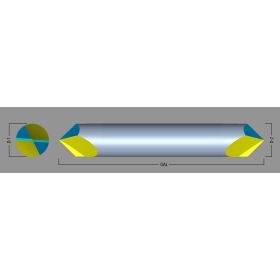A chamfer cutter, or even a chamfer mill, are available at any machine shop, assembly floor, or hobbyist’s garage. These cutters are simple tools that are useful for chamfering or beveling any part in the wide variety of materials. A lot of to chamfer a part, including fluid flow and safety, to part aesthetics.

Due to diversity of needs, tooling manufacturers offer many different angles and sizes of chamfer cutters, as well as several types of chamfer cutter tip geometries. Harvey Tool, for example, offers 21 different angles per side, which range from 15° to 80°, flute counts of two to, and shank diameters starting at 1/8” around One inch.
After getting a tool with all the exact angle they’re searching for, a customer might have to go with a certain chamfer cutter tip that would work best with their operation. Common forms of chamfer cutter tips include pointed, flat end, and end cutting. The subsequent three types of chamfer cutter tip styles, provided by Harvey Tool, each serve a unique purpose.
Three Varieties of Harvey Tool Chamfer Cutters
Type I: Pointed
This brand of chamfer cutter may be the only Harvey Tool option which will come into a sharp point. The pointed tip enables the cutter to complete in smaller grooves, slots, and holes, in accordance with another two types. This style also permits easier programming and touch-offs, since point can be simply located. It’s due to its tip this form of the cutter has got the longest period of cut (together with the tool coming to a finished point), compared to the flat end with the other sorts of chamfer cutters. With only a two flute option, this can be the easiest sort of a chamfer cutter available from Harvey Tool.
Type II: Flat End, Non-End Cutting
Type II chamfer cutters are extremely just like the type I style, but feature a finish that’s ground right down to a designated, non-cutting tip. This flat “tip” removes the pointed area of the chamfer, which is the weakest area of the tool. For that reason alternation in tool geometry, it emerged a different measurement based on how much longer the tool could be when it stumbled on a point. This measurement is termed “distance to theoretical sharp corner,” which assists together with the programming in the tool. The main benefit of the flat end with the cutter now enables multiple flutes to exist around the tapered profile from the chamfer cutter. With an increase of flutes, this chamfer has improved tool life and take care of. The flat, non-end cutting tip flat does limit its use within narrow slots, but an additional is often a lower profile angle with better angular velocity at the tip.
Type III: Flat End, End Cutting
Type III chamfer cutters are an improved and more advanced version of the sort II style. The kind of III boasts a flat end tip with 2 flutes meeting at the center, creating a center cutting-capable form of the sort II cutter. The very center cutting geometry with this cutter can help you cut featuring its flat tip. This cutting allows the chamfer cutter to lightly reduce the very top of a part to the bottom from it, as an alternative to leave material behind when cutting a chamfer. There are several situations where blending of your tapered wall and floor is necessary, and this is where these chamfer cutters shine. The top diameter is also held to a tight tolerance, which significantly is great for programing it.
To conclude, there can be many suitable cutters for any single job, and you will find many questions you have to ask before picking your ideal tool. Selecting the best angle depends upon making sure that the angle on the chamfer cutter matches the angle on the part. You need to be cautious of the way the angles are known as out, as well. Could be the angle an “included angle” or “angle per side?” Could be the angle called off from the vertical or horizontal? Next, the larger the shank diameter, the stronger the chamfer as well as the longer the length of cut, these days, interference with walls or fixtures must be considered. Flute count comes down to material and take care of. Softer materials usually want less flutes for better chip evacuation, while more flutes will be finish. After addressing all these considerations, the correct kind of chamfer for your job must be abundantly clear.
For more details about chamfer cutter explore this popular net page
